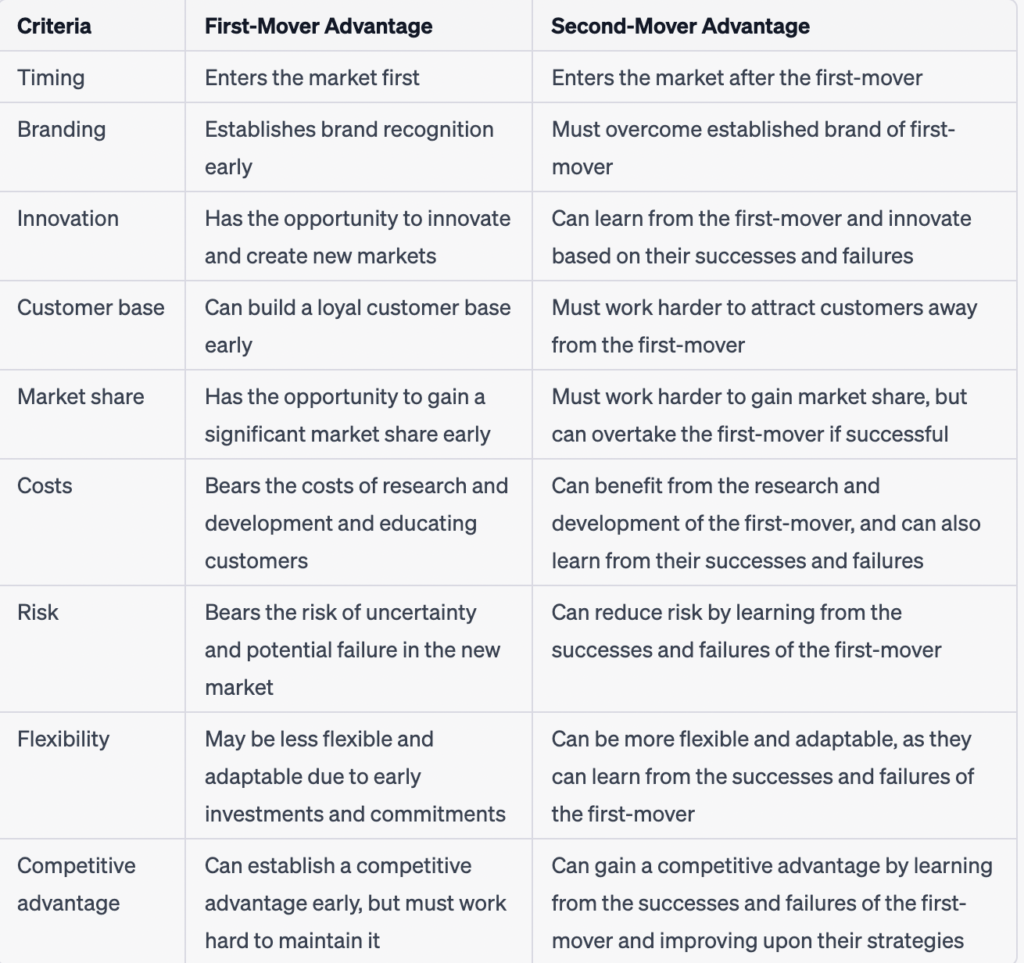The First Mover Advantage (FMA): Is It Worth the Risk?
As an entrepreneur, you’ve probably heard the term “first mover advantage” (FMA) thrown around a lot. But what exactly is it, and is it worth the risk? In this post, we’ll dive deep into the world of FMAs and explore the advantages and disadvantages of being the first mover in a market.
What is First Mover Advantage?
The first mover advantage is the competitive advantage gained by a company that is the first to enter a new market or introduce a new product. This advantage can be significant, as the first mover has the opportunity to capture a large portion of the market share and establish brand recognition before any competitors can enter the market.
The term “first-mover advantage” is generally attributed to economist Joseph Schumpeter, who used the term in his 1934 book “The Theory of Economic Development.” Schumpeter argued that the first company to introduce a new product or service into the market could gain a significant advantage over its competitors, as it would be able to capture market share and establish itself as the dominant player in the industry.
The concept has since been widely studied in the fields of economics, marketing, and strategic management.
Advantages of First Mover Advantage
One of the biggest advantages of being the first mover is the ability to establish brand recognition and customer loyalty. By introducing a new product or entering a new market before anyone else, a company can establish itself as the industry leader and gain the trust and loyalty of customers. This can be especially important in industries where customers are likely to stick with a brand once they’ve established a relationship.
Another advantage of being the first mover is the ability to establish relationships with suppliers, distributors, and other key players in the market. By being the first to enter a market, a company has the opportunity to establish relationships with key players before anyone else can. This can give the company a significant advantage in terms of securing resources and partnerships that can help them grow and expand.
Disadvantages of First Mover Advantage
While there are certainly advantages to being the first mover in a market, there are also significant disadvantages. Perhaps the biggest disadvantage is the risk involved. Being the first to enter a new market or introduce a new product is a risky move, as there is no guarantee that the market will develop as expected or that the product will be successful.
Another disadvantage of being the first mover is that competitors can learn from your mistakes. If you’re the first to enter a market, you’ll be the one figuring out what works and what doesn’t. This can be a costly and time-consuming process. Meanwhile, competitors can learn from your mistakes and enter the market with a better understanding of what works and what doesn’t.
Examples of Successful First Movers
There are many examples of the first mover advantage strategy, where a company is the first to enter a new market or introduce a new product. Some notable examples include:
- Amazon: Amazon was one of the first companies to sell goods online, and it quickly established itself as the market leader in e-commerce. By being the first to enter the online retail space, Amazon was able to build a massive customer base and dominate the industry.
- Apple: When Apple introduced the iPhone in 2007, it was the first smartphone of its kind. Apple’s early entry into the smartphone market gave it a significant advantage over competitors, and the iPhone has remained one of the most popular smartphones in the world.
- Microsoft: Microsoft was one of the first companies to develop software for personal computers. Its early operating systems, such as MS-DOS and Windows, quickly became the industry standard, giving Microsoft a dominant position in the software market that it still holds today.
- Netflix: When Netflix first started, it was one of the only companies offering DVD rentals by mail. By being the first mover in this space, Netflix was able to dominate the industry and eventually transition to a streaming model, which it also dominated.
- Tesla: Tesla was one of the first companies to focus on electric vehicles, and it quickly established itself as a leader in the industry. By being the first to offer high-quality electric vehicles, Tesla was able to build a strong brand and a loyal customer base.
- Airbnb: Airbnb was one of the first companies to offer short-term rentals through an online platform. By being the first mover in this space, Airbnb was able to establish itself as the dominant player in the industry and build a massive user base.
These are just a few examples of companies that have successfully used the first-mover advantage strategy to establish themselves as leaders in their industries.
However, it’s worth noting that being the first mover is not a guarantee of success, and there are many examples of companies that failed to capitalize on the first mover advantage.
It’s important to do your research, understand the market, and have a solid plan in place before pursuing an FMA strategy.
Tips for Success as a First Mover
If you do decide to pursue an FMA strategy, there are a few things you can do to increase your chances of success.
- Research the market: Before entering a new market, be sure to do your research. Understand the needs and preferences of your target customers, and assess the competition. This will help you develop a product or service that meets the needs of the market and stands out from the competition.
- Be flexible: Being the first mover means you’ll be figuring things out as you go along. Be prepared to pivot and adjust your strategy as needed. Stay open to feedback and be willing to make changes based on what you learn.
- Build relationships: As mentioned earlier, being the first mover gives you the opportunity to establish relationships with key players in the market. Take advantage of this by building strong relationships with suppliers, distributors, and other partners.
- Focus on quality: When introducing a new product or service, quality is key. Make sure your product or service is of the highest quality possible to establish a strong reputation and gain the trust of customers.
- Stay ahead of the competition: Being the first mover doesn’t mean you can rest on your laurels. Stay ahead of the competition by continually innovating and improving your product or service.
First mover advantage vs second mover advantage
The first-mover advantage refers to the advantages a company can gain by being the first to enter a new market or introduce a new product.
The second-mover advantage refers to the advantages a company can gain by learning from the successes and failures of the first-mover and innovating based on their strategies.
Both approaches have their advantages and disadvantages, and the best strategy depends on the specific circumstances of the market and the company’s goals and resources.

Related Posts
Conclusion
So, is the first mover advantage worth the risk? It’s difficult to say for sure. While there are certainly advantages to being the first to enter a market or introduce a new product, there are also significant risks involved. Ultimately, it’s up to each entrepreneur to weigh the risks and rewards and decide whether or not to pursue an FMA strategy.
One thing is for sure, however: being the first mover isn’t a guarantee of success. It takes a combination of luck, skill, and hard work to succeed in any market. But for those willing to take the risk, the rewards can be significant. So, if you’re considering an FMA strategy, be sure to do your research, understand the market, and have a solid plan in place before diving in.


















